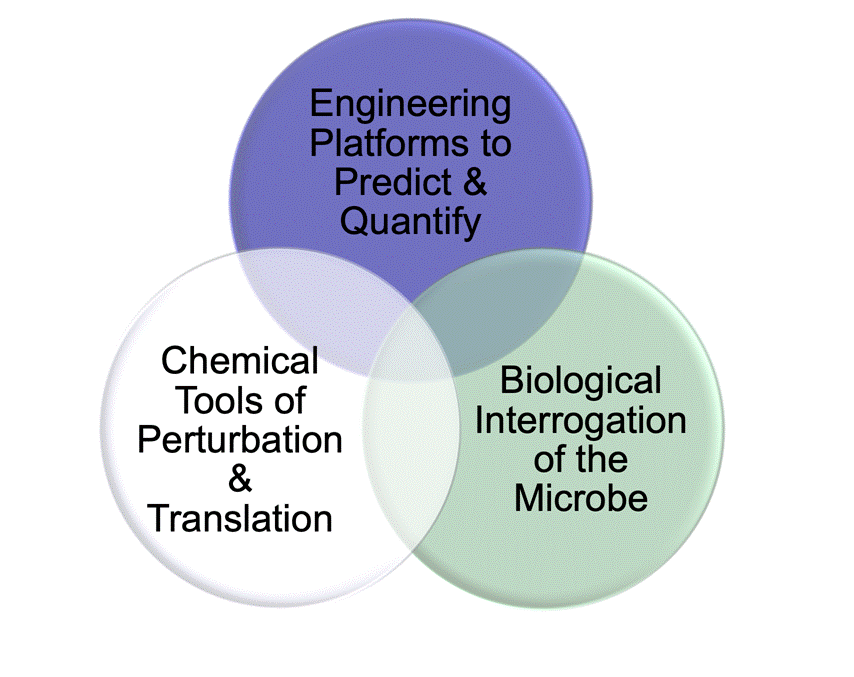Engineering New Platforms for the Study of Infectious Diseases

Examples of Key Questions Posed by the Freundlich Laboratory:
Can structure-based design approaches yield small molecule anti-infectives of translational value in comparison to high-throughput whole-cell phenotypic approaches?
Can we embrace the big data arising from these high-throughput whole-cell phenotypic screens and leverage machine learning approaches to discover and then optimize small molecule anti-infectives of translational value? In so doing, can we predict complex molecular properties such as in vivo efficacy and pharmacokinetic profile with machine learning approaches?
When trying to understand the mechanism of action for a hit from a whole-cell phenotypic screen or probing the correlation between chemical structure and the engagement of a known target within the cell, can we quantitatively assess small molecule accumulation and metabolism within the cell?
The Freundlich group is located at Rutgers University in the Department of Pharmacology, Physiology and Neuroscience and the Department of Medicine (Division of Infectious Diseases, Center for Emerging & Re-emerging Pathogens). Professor Freundlich is a member of the Infection, Immunity & Inflammation, Biomedical Engineering, and Molecular Biology, Genetics & Cancer tracks, while also holding a full member appointment in the graduate program for the Department of Medicinal Chemistry. The Freundlich laboratory is positioned at the intersection of computation, chemistry, and biology to develop new tools that contribute to our understanding of the pathogenesis of infectious diseases (caused by M. tuberculosis, ESKAPE bacteria, and select viruses) and translate these toward the discovery of novel therapeutic strategies. The group is indebted to funding primarily from the National Institutes of Health.
Computational workflows, based on machine learning methods with or without high-throughput target-based virtual screening, are devised to discover new small molecule chemical tools with efficacy versus a specific bacterial agent and then evolve the activity, physiochemical, Absorption-Distribution-Metabolism-Excretion-Toxicity, and pharmacokinetic/pharmacodynamic profiles such that in vivo validation is achieved. Over the years, the lab has contributed to a suite of machine learning tools that are used for its own programs as well as offered to the scientific community. We assert that learning from chemical and biological big data can inform the discovery and evolution of the next generation of therapeutic regimens to treat infectious diseases.
Chemical strategies are leveraged with these computational approaches in the optimization of molecules to ultimately target the demonstration of potent efficacy in a relevant animal model of disease. The methodologies of synthetic organic chemistry are required to prepare targeted small molecules on the milligram through multigram scales. Cycles of optimization are often required to obtain a compound profile sufficient to afford in vivo efficacy. A tuberculosis program within the laboratory has attained preclinical status through the demonstration of potent efficacy in the mouse model of M. tuberculosis chronic infection. Our chemistry resources have also impacted the tuberculosis clinical domain through providing novel imaging agents to enable measurements within the infected host as to drug distribution.
Biological methods in the laboratory contribute to a fundamental understanding of the mechanism of action of our antibacterial agents. Biochemistry, microbiology, and genetics are harnessed to identify the biological target/s of the small molecule. A particular focus is on intrabacterial drug metabolism (IBDM) which borrows from the practice of metabolomics to interrogate the biotransformation of drugs and chemical tools within the bacterium. This has led to an enhanced understanding of xenobiotic metabolism within bacteria while informing our efforts to evolve new therapeutic strategies.

Statement on Diversity and Inclusion
We value and welcome people of all races, genders, sexual orientations, religions, abilities, ethnicities, and identities. We celebrate and welcome the unique backgrounds, life experiences, and perspectives that each individual offers.
We do not accept and we reject hateful speech and actions aimed to demean or injure any person through the use of racism, sexism, misogyny, homophobia, transphobia, xenophobia, ableism, classism, or any other forms of discrimination.
